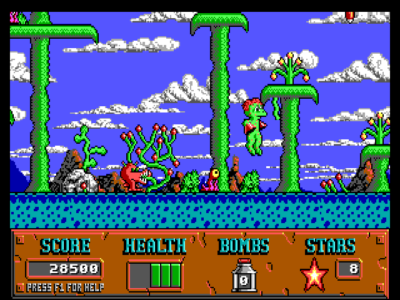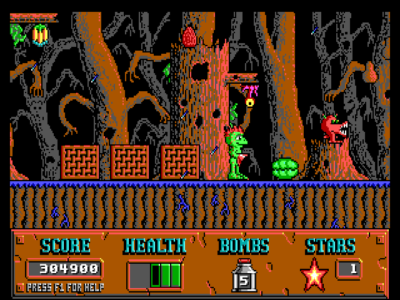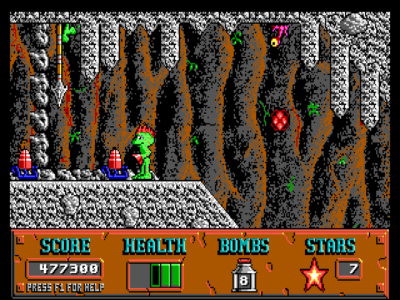
Cosmo’s Cosmic Adventure
Written by: Stoo
Date posted: May 16, 2010
- Genre: Action
- Developed by: Apogee
- Published by: Apogee
- Year released: 1992
- Our score: 6
Any discussion of platform games on the PC in the early 90s will feature Apogee quite prominently. Our system may not have been well supported compare to consoles or other home computers – PCs of the time still often had outdated graphics and sound and they were seen as boring workstations. Apogee however led the way in filling the gap in the market, producing some decent action gaming, for those of us defiantly sticking with the beige box. (Ok I kinda wanted a SNES but it never happened).
We’ve already looked at their most significant platform series, Commander Keen, developed by iD software. The first of those was in fact the first ever scrolling platformer on PC (several years after Mario did it on the NES), and Keen himself was probably the nearest thing the shareware scene had to a mascot. It’s also worth remembering that Duke Nukem began life as a platformer, before he went all 3D, started hanging around sleazy strip clubs and then disappeared into the world’s most famous pieces of vapourware for fifteen years. Today though we’re looking at Cosmo’s Cosmic Adventure, another in-house job developed by Todd Replogle, a co-creator of Duke.

Some cheery EGA.
Like all of Apogee’s games, this one was released using the Shareware model. You could pick up essentially an entire game for free; a short game for sure around eight or nine levels, but still more content than what we’d consider a demo. If you liked it, you could go buy further chapters (two in this case). Both the wider shareware scene and Apogee benefitted from this model, which would hold out past the general decline of 2d action and into the early days of 3D first-person shooters. I have to add a disclaimer though, here I’ve only played the first chapter. So if there’s some major change in gameplay dynamics later on, or it gets stupidly hard or something, write in and let me know.
So in this game you’re a… green alien child. With suckers for hands. Yeah it’s kind of cutesy but bear with me. He’s lost his mum and dad, when they landed on a strange world to make repairs to their ship on the way to disney world. Come on, you want to help the poor kid find his folks, don’t you? To ease your conscience for that campaign of bloodthirsty conquest in Total War. Or that trail of wreckage you left along the roadsides in Vice City. Or the endless, endless carnage of Syndicate.
As you venture into this wacky alien world, you’ll note that even by 1992 standards the graphics were a bit behind the curve, sticking with good old 16-colour EGA. That said it’s not too hard on the eye – the artwork is colourful, cartoony and really quite appropriate. There’s a decent variety in level styles too – outdoor wilderness, spooky forest, caves and a kind of scifi-industrial. In the outdoor maps the game sports parallax scrolling, giving an illusion of depth to the backdrops by having them scroll at a different speed to the foreground.

The spooky forest level is enhanced with rain and lightning effects.
To accompany all this you have some cheerful adlib music, ie FM synthesis. It’s cheerful and again fitting. As for sound effects however are tortured squawking noises out of the PC’s internal speaker, that the most basic of hardware standard to all PCs. To be fair Soundblaster (ie hardware that could play back digitally recorded effects) wasn’t quite universal at the time. Still I kinda wish they’d gone for adlib-generated effects, as seen in Keen – it might not have been much more real, but was at least more mellow.
In play, it’s yer basic “jump on their heads” style platformer. As opposed to a “shooty” platformer (Megaman) or a “cinematic acrobatics” platformer (Prince of Persia). There probably are more formal terms but I’m sure you get the idea. To give the game its own feel though, they added in a couple of key gameplay features. One is Cosmo’s sucker-hands letting him cling onto vertical surfaces, and also hop along upwards. Also you have little time-bombs, not really plentiful enough to use as regular weapons but they can help you reach items and remove obstacles.
Enemies meanwhile are mostly cartoonish little monsters, as is befitting. Although I spotted a couple that were directly taken from the Mario games – stone block things that grimace as they pound downwards and ghosts that move towards you when your back is turned. I really couldn’t tell you if this was intended as a tribute or just blatant copying to cut corners at the design stage.

Obligatory cave level.
Oh dear, this is going to be a short review. What else? Well, apogee really loved their points-items, random stuff like fruit of gems you pick up to rack up the score (in fact such things even persisted into their early first-person shooters). So you can take the extra time to hunt all the items if you like, I have to admit I’m too lazy to care much about the scoreboard. Although once nice touch I liked is how sometimes if you’re standing on a ledge, points items will be arranged in an arc to suggest to you which way to jump through the air, towards another platform out of sight.
So overall I’m not going to claim your Amiga and Megadrive owning buddies should have been insanely jealous. As nostalgic as I am for Apogee I don’t think they and their peers managed to make the PC equal to other systems for platform gaming. Cosmo is, however, very playable. Shame about the lack of sound card support but otherwise this is a well made little platformer that does most things right. So if you’d like a break from from endless dungeon questing or war campaigns or piloting mechs or whatever, there’s certainly some fun to be had kicking back with some old fashioned EGA fun.


 Posts
Posts